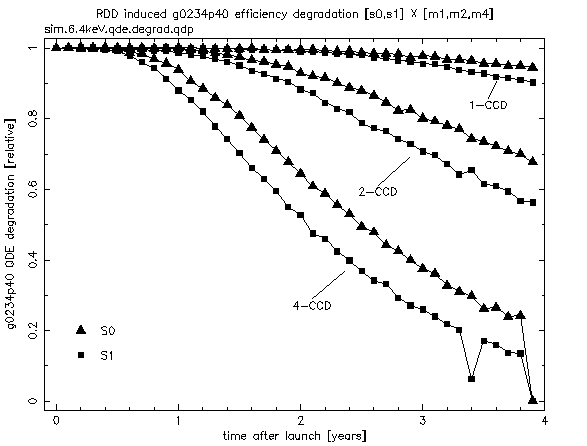The Effect of RDD on SIS data
Recent investigations by the SIS team (Rasmussen, as well as Yamashita and Dotani) have revealed the overriding importance of RDD.
What is RDD?
CCDs always have read out noise: pixels without photon or particle events will have a mean of "dark level" and some distribution around this mean level. This is usually treated as Gaussian distribution. In the case of ASCA, the on-board processor maintains a coarse map of the dark levels (each chip is divided into 16 by 16 regions by default) and subtracts these from individual pixel values. The dark frame map is calculated assuming a symmetric noise around the mean dark level. Unfortunately, the cumulative effects of radiation damage have created a population of active pixels which skews this distribution, leading to imperfect dark level subtraction on-board. This effect is called the Residual Dark Distribution, or RDD.Charges created by X-ray photons may be recorded in a single pixel or in two or more neighboring pixels. When a significant charge is detected in a pixel, its neighbors are examined for significant charges. If only the central pixel has a significant charge, its value is recorded and the event is assigned a "grade" of 0. If some of the neighbors have significant charges, then these are added to that of the central pixel, and a higher grade is assigned to the event. The calculation of final PHA value and the grade is done on-board in Bright mode data, and on the ground for Faint mode data; the latter gives a finer control over the process but cannot remove all the effects of RDD.
The effect of RDD is to impair the ability of the on-board processor to assign the correct grade to an event. For example, a grade 0 event may be recognized as a higher grade event because a neighboring pixel is very active. For higher grades, this effect is worse and can even resluts in a true photon event being classified as grade 7, i.e., as a rejected particle event. Thus the effect of RDD is a complex interplay of the analog electronics, on-board digital processing and off-line processing, and involves intrinsic randomness of these active pixels.
RDD is clocking-mode dependent: the longer you integrate, the bigger RDD becomes. Therefore, it is most pronounced in 4-CCD mode (16 s integration), and less important in 1-CCD mode (4 s integration).
The Bottom Line:
- Grade branching ratios are changing (i.e., the proportions of events in various grades).
- The Quantum Detection Efficiency (QDE) of SIS is degrading (because real events are being rejected).
- The spectral resolution is degrading (because of higher noise and because there are apparently fewer events at the lower grades).
- The energy scale is changing.
- 4-CCD mode is affected by RDD much more than 1-CCD mode.
Quantitative effects of RDD
All these effects are strong in 4-CCD mode, while 1-CCD mode remains little affected. Here are some numbers, using the current understanding of the RDD effect as parameterized by the SIS team.
---------------------------------------------------------
| QDE (as approximate percentage of nominal) |
|--------------------------------------------------------
| 2 years after launch 3 years after launch |
| |
| 4-CCD 55-70 25-40 |
| 2-CCD 90-95 70-80 |
| 1-CCD 100 95 |
---------------------------------------------------------

---------------------------------------------------------
| SPECTRAL RESOLUTION (at 6.4 keV in eV) |
|--------------------------------------------------------
| 2 years after launch 3 years after launch |
| |
| 4-CCD 150 --- |
| 2-CCD 60 80 |
| 1-CCD --- 20 |
---------------------------------------------------------
---------------------------------------------------------
| ENERGY SCALE OFFSET* (in eV) |
|--------------------------------------------------------
| 2 years after launch 3 years after launch |
| |
| 4-CCD 100 200 |
| 2-CCD 15 40 |
| 1-CCD --- < 5 |
---------------------------------------------------------
* The RDD-induced energy scale offset is independent of energy

Recommendation for dealing with RDD
FOR UPCOMING OBSERVATIONS: The GOF recommends that the use of 4-CCD mode be discontinued and that 2-CCD mode be used with caution.FOR EXISTING DATA: The calibration effort continues. SIS team members are experimenting with various approximations to generate better and time-dependent response matrices. Watch this space for new releases.
FOR AO-4 PROPOSALS: Those proposing to observe extended sources should perhaps consider focusing on the GIS - its performance has shown almost no detectable degradation.
If you have any questions concerning ASCA, visit our Feedback form.

